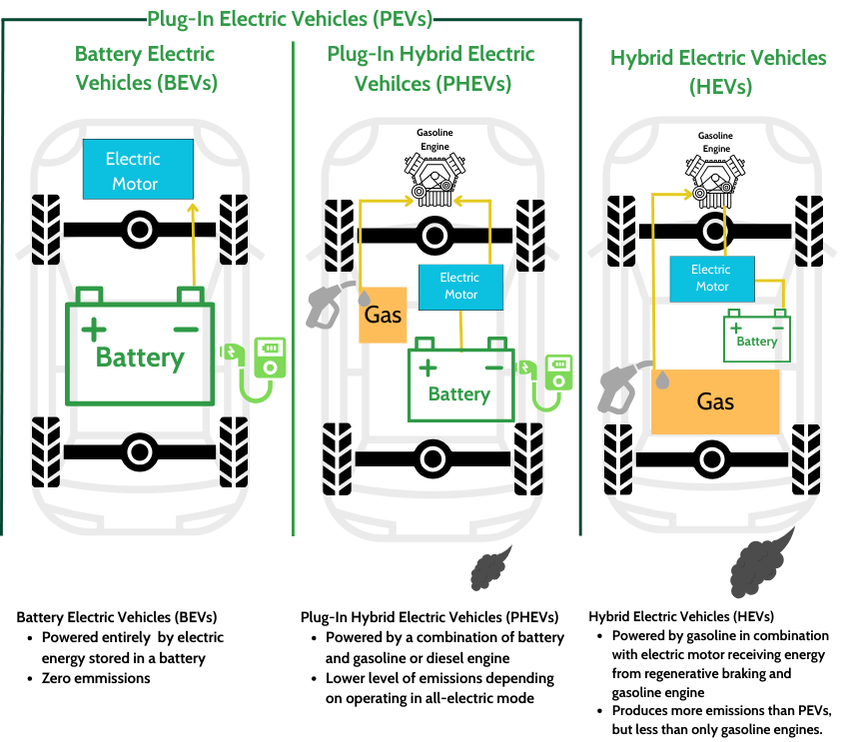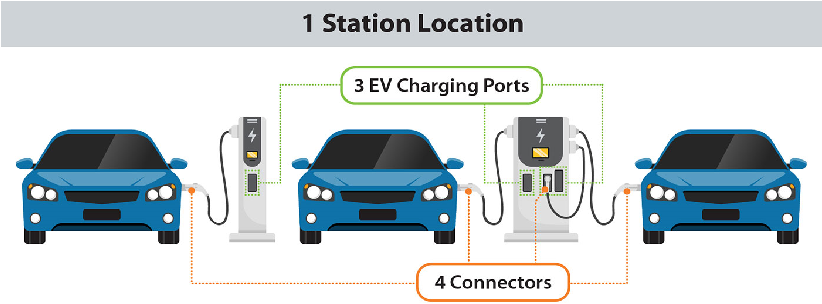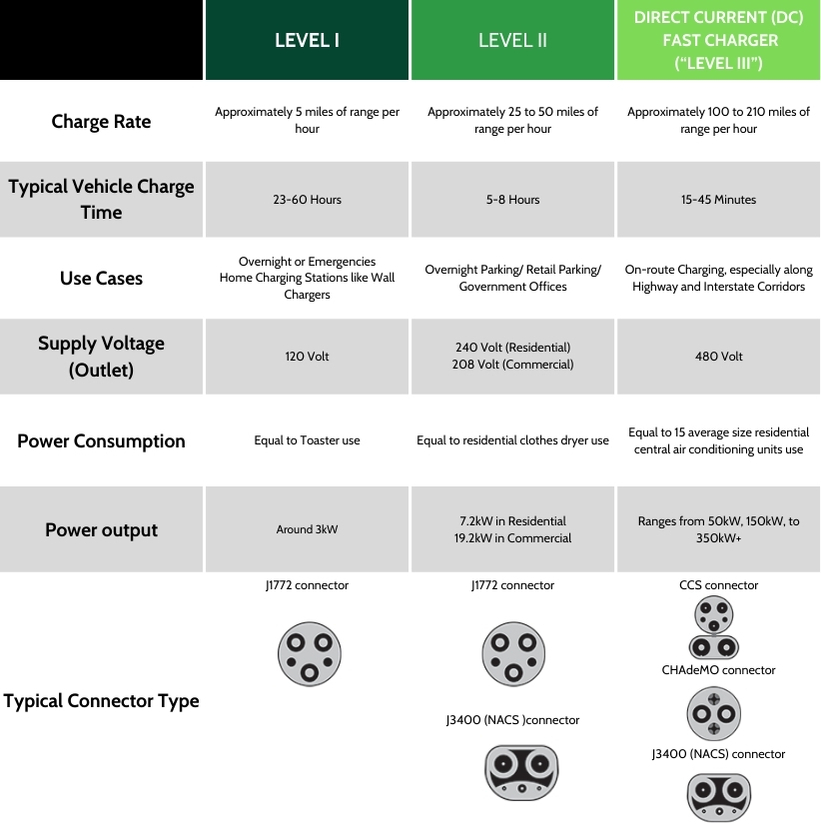Electric Charging Toolbox

Why is Electric Vehicle Charging important to us?
OTO’s long range transportation plan Destination 2045 sets a goal to build a transportation system that supports a resilient region that is prepared for the future, specifically to maintain environmental quality, develop resiliency to external factors, manage congestion, and plan for electric vehicles and other upcoming technologies. This vision was shared by local leaders and the public which described the scenery and the natural environment as the top strength of the region’s transportation system, as well as identifying electric vehicle planning as an opportunity to address the region's needs.
As a center for regional and national travel, the region should also plan to provide a convenient EV infrastructure network. This allows people to use the highway network to travel to their destination without concerns for where they need to stop to complete their journey. This toolbox will provide local municipalities, private enterprises, and the public with a basic understanding of electric vehicle charging and resources on how to plan for future needs.
Electric Charging Basics
-
There are different types of Electric Vehicles that use electricity in various ranges to improve vehicle efficiency.

Please click on the image, to view the full image with a mobile device or tablet. BEVs and PHEVs are considered Plug-In Electric Vehicles (PEVs) because they can be fueled fully or partially through electricity. The driving range of PEVs depends on the manufacturer and model of the vehicle and also the driving behavior. The average range of Electric Vehicles is between 200 and 300 miles on a fully charged battery and the average American household drives around 50 miles per day. A comprehensive list of electric vehicles can be found on the website of the U.S. Department of Energy - Alternative Fuels Data Center under "Availability of Electric Vehicles."
-
Charging Infrastructure varies depending on the available electric infrastructure. Currently most PEV owners do the majority of their charging at home, which mostly provides a lower supply of voltage and amperage and thus has longer charging times. Public facilities aim for faster charging with different levels of power available.
What is an Electric Vehicle Charging Station?
An electric vehicle charging station is a designated location where electric vehicles (EVs) can recharge their batteries. These stations are commonly found in various public places, such as parking garages, shopping malls, and along highways, allowing drivers to easily access charging while on the go.

Please click on the image, to view the full image with a mobile device or tablet. Location
In this context, a charging station is called a "location." This means it’s a specific site that has one or more electric vehicle service equipment (EVSE) units. For example, a mall parking lot might have several charging stations, each able to power up different vehicles.
Port
The "port" refers to the charging unit itself that provides electricity to one electric vehicle at a time. This means that if multiple cars arrive at a charging location, they will each need their own charging unit to charge simultaneously.
Connector
A connector is the physical piece that connects an EV to the charging station. It can be a socket or a cable. Each charging unit may have different types of connectors, like CHAdeMO or CCS (Combined Charging System). However, only one connector can be used at a time, so drivers need to choose the right one for their vehicle.
In summary, an electric vehicle charging station includes the location, the charging unit (port) that supplies power, and the connector that links the vehicle to the charging station. This infrastructure is essential for making it easy for everyone to use electric vehicles.
Overview of Charging Equipment
Charging equipment for plug-in electric vehicles (PEVs) is grouped by how quickly it charges the batteries. Level I and II charging use alternating current (AC) charging, which means an electric current that reverses its direction many times a second on regular intervals. Fast Chargers use direct current (DC) meaning an electric current that flows in only one direction and thus allows faster charging through constant voltage. The below table shows some of the differences of the different charging levels.

Please click on the image, to view the full image with a mobile device or tablet. Charging ranges and speeds depend on multiple factors, including battery level, vehicle type and manufacturer, charging station, and weather. A battery will charge faster when it has a lower state of charge and slows as it reaches full capacity. Level I and Level II charging stations maintain relatively consistent charging speeds, however DC fast charging stations are typically most rapid between 20% and 60%, with speeds slowing significantly between 80% and 100%. The installed batteries from different manufacturers also have different maximum allowable charging rates, meaning that a station might offer a higher kilowatt (kW) output than then the maximum input of the car, thus the vehicle charge time might be longer due to the vehicle type. Lastly the outside temperature can slow down the charging speed. Electric vehicle batteries prefer temperatures not being too cold or hot. For example, the charging of a battery creates heat and the battery thermal management system (BTMS) prevents the battery from overheating and will slow down the charging speed if the battery gets too hot.
A note on connector types:
The shown connector types are the currently common connectors in North America. There are adapters available for all connector types to connect to other systems. However, EV manufacturers have agreed to adopt the North American Charging Standard (NACS) and starting in 2025 or 2026 all new vehicles will be equipped with NACS.
-
Equipment and Installation
The installation costs of an EV charging port depend on the charging level of the port(s) and the existing infrastructure. In 2024, the estimated costs for the equipment for a residential Level 1 charger is about $300 to $600 and for a residential Level 2 charger around $500 to $700. These costs are only for the charging equipment, while the labor costs can be up to $1,000. Equipment for commercial Level 2 charger costs between $8,000 to $10,000 for a charger with two ports. DC fast chargers cost around $70,000 to $150,000 for a charger with two ports. Additional costs for the installation can vary widely based on the location and the existing infrastructure. For example, some sites will require the installation of a transformer as well, which can cost $5,000 or more.
Maintenance
Maintaining charging stations involves securely storing cables, regularly checking parts, and keeping the equipment clean. Chargers may need occasional repairs, and warranty costs differ by manufacturer. Maintenance can be low-key, but fixing broken chargers can be expensive if they’re out of warranty. It’s crucial to clarify who pays for maintenance—whether it’s the site host, charging network, or installer. Maintenance contracts should specify response times and uptime requirements. On average, owners should expect to spend about $400 to $1,000 a year per charging port on maintenance, depending on the charger type and if it's connected to a network. Depending on your funding source there also may be maintenance and reporting requirements which have an effect on the costs.
Fees
The costs for the electricity depends on the responsible utility provider and it is important to include the utility provider early in the planning phase for the installation of EV charging infrastructure. The local utility provider is an important partner that can help provide information regarding installation and operation costs. The common pricing structure for charging users include by kilowatt hour (kWh), by session, by length of time, or through a subscription. In 2024, DC fast charging prices per kWh range from $0.24 to $0.70 in the OTO area with idle fees of $15 to $20 per hour for vehicles staying connected and parked in the charging spot longer than half an hour after completing charging. Level 2 charging prices range from $0.18 to $0.23 in the OTO area in 2024. Some locations offer free charging or take a flat fee for charging per hour or per spot. For more information on current pricing visit websites like plugshare.com, which provide information on pricing, charging speeds and availability of locations and also offer reviews from other users.
Planning ahead
Many electric vehicle (EV) owners charge at home, while currently most charging stations are built by private companies. This puts the responsibility on local municipalities to create accessible public EV infrastructure for everyone, including renters, travelers, and business fleets that need frequent charging.
In the Springfield metro area, the small number of EV owners presents an opportunity for better planning of future growth. Local municipalities can encourage employers and private developers to integrate EV charging options in office spaces and new multi-family housing projects. This includes planning for EV parking spots that won’t take away from other residents and ensuring they are close to existing electric infrastructure or can access existing electric infrastructure easily.
Additionally, municipalities can develop public EV charging options in on-street parking and public lots near commercial areas, parks, and government buildings.
The below map gives an overview of available and planned charging stations in the OTO area. It can also be used to plan for future public EV infrastructure projects by showing current infrastructure, demographic data, and multi-family housing density. The Alternative Fuels Data Center also provides an EV Infrastructure Toolbox, which offers resources for estimating charging Infrastructure needs.
Funding Opportunities
Funding for electric vehicles is important for local communities because building the necessary infrastructure can be expensive.
-
Please note that this is a general list of potential grant opportunities for EV charging infrastructure. Current grant opportunities for the OTO area can be found on OTO's grants website or by subscribing to OTO's newsletter at the bottom of this page.
Charging and Fueling Infrastructure (CFI) Grant Program
The CFI grant program is a competitive grant program through the Federal Highway Administration (FHWA). The program was established by the Infrastructure Investment and Jobs Act (IIJA), also called the Bipartisan Infrastructure Law (BIL) and will provide $2.5 billion over five years for deployment of publicly available electric vehicle charging and alternative fueling infrastructure in urban rural areas and along designated Alternative Fuel Corridors (AFC).
For more information visit USDOT's CFI general grant program information website.
National Electric Vehicle Infrastructure (NEVI) Formula Program
The NEVI formula Program is a grant program which directs apportions of the program funding among States based on the State's share of the combined amount of FHWA distributions of Federal-aid highway apportionments. The program was also established by IIJA/ BIL and will provide $5 billion over five years to provide funding to States to strategically deploy electric vehicle (EV) charging infrastructure and to establish an interconnected network to facilitate data collection, access, and reliability. The State of Missouri received close to $57 million through the NEVI program for FY 2022 to FY 2024. For more information on the general NEVI program visit FHWA's NEVI formula website.
For more information on the Missouri's NEVI program, including the state's NEVI plan and when grant funding might be available use the resource link for MoDOT - National Electric Vehicle Infrastructure Formula Program.
Federal Tax Credits for New & Used Electric Vehicles and EV Charging Equipment
The Internal Revenue Service (IRS) has a program that provides up $7,500 in tax credits for new clean vehicles that were purchased or leased between 2023 and 2032. For more information, including eligibility and how to receive the credit visit the IRS new clean vehicles website.
The IRS also has a tax credit program for used electric vehicles that were purchased after January 1, 2023. For more information, including eligibility and how to receive the credit visit the IRS used clean vehicles website.
Alternative Refueling Equipment purchased after 2022 is also eligible for IRS tax credits. For more information, including eligibility and how to receive the credit visit the IRS from 8911 website.
-
Some local electric utility providers offer incentive programs for installing residential EV charging infrastructure.
City Utilities (CU) offers its customers rebates for installing certain residential EV chargers or for upgrading their electric outlets for residential EV chargers. They also offer an EV-Ready Home Rebate for builders and developers of residential properties. For more information go to CU's EV charging Rebates page.
White River Valley Electric Cooperative (WRVEC) offers a rebate for residential and commercial members of the cooperative to install an energy star certified Level 2 (240V) EV Charger. For more information visit the White River Valley Electric Cooperative EV info website.
Resources
There are a large number of resources available from federal or state agencies and private organizations. Below are a few very helpful resources to help plan for EV charging infrastructure.
U.S. Department of Energy - Alternative Fuels Data Center
"The Alternative Fuels Data Center (AFDC) is a resource for information, data, and tools to help find ways to reduce petroleum consumption through the use of alternative and renewable fuels, advanced vehicles, and other fuel-saving measures."
MoDOT - National Electric Vehicle Infrastructure Formula Program
Following the establishment of the NEVI formular program, the Missouri Department of Transportation (MoDOT) adopted a statewide Electric Vehicle Infrastructure Plan in 2022, which outlines the goals and strategies for the state NEVI formula funds.
JOET - Public Electric Vehicle Charging Infrastructure Playbook
The Joint Office of Energy and Transportation (JOET) developed a guidebook that "provides interactive resources to help communities plan and build the infrastructure needed to support a zero-emission transportation system."
U.S. Access Board - Design Recommendations for Accessible Electric Vehicle Charging Stations
"The U.S. Access Board, an independent federal agency that issues accessibility guidelines under the Americans with Disabilities Act (ADA), Architectural Barriers Act (ABA), Rehabilitation Act of 1973, and other laws, is providing a technical assistance document to assist in the design and construction of electric vehicle (EV) charging stations that are accessible to and usable by people with disabilities."
Clean Cities and Communities
Clean Cities and Communities (CC&C) is a U.S. Department of Energy (DOE) partnership to advance clean transportation nationwide. The Ozarks Clean Fuels Coalition is the local coalition, which with vehicle fleets, fuel providers, community leaders, and other stakeholders to identify community-driven choices that save energy and promote the use of alternative fuels and advanced vehicle technologies in transportation.
Electrification Coalition - EV Funding Finder
The Electrification Coalition is a nonpartisan, nonprofit organization that works to accelerate the widespread adoption of light-, medium-, and heavy-duty electric vehicles. The Coalition developed a tool to identify federal funding opportunities.
Fuel Institute - A Best Practice Guide for EVSE Regulations
"This guide has been prepared to help state and local officials and other readers understand in brief form the policy landscape in the U.S. at both the state and local levels, noting the types of policies that have been set and providing several examples of how different authorities having jurisdiction (AHJ) have implemented them."
Argonne National Laboratory - Facts About Electric Vehicles
Argonne National Laboratory has published a EV facts and common questions paper. Argonne also has a Facts About Electric Vehicles webpage where you can learn more about EV owner satisfaction, fuel savings, grid benefits, and more topics. Learn more on Argonne National Lab’s website.
National Renewable Energy Laboratory (NREL) - Total Cost of Ownership Tool
"The National Renewable Energy Laboratory (NREL) has launched a new iteration of its Transportation Technology Total Cost of Ownership (T3CO) tool. The rebuilt tool provides researchers, fleet owners, and operators with faster, more comprehensive insights into the life cycle costs of decarbonized commercial vehicles."










